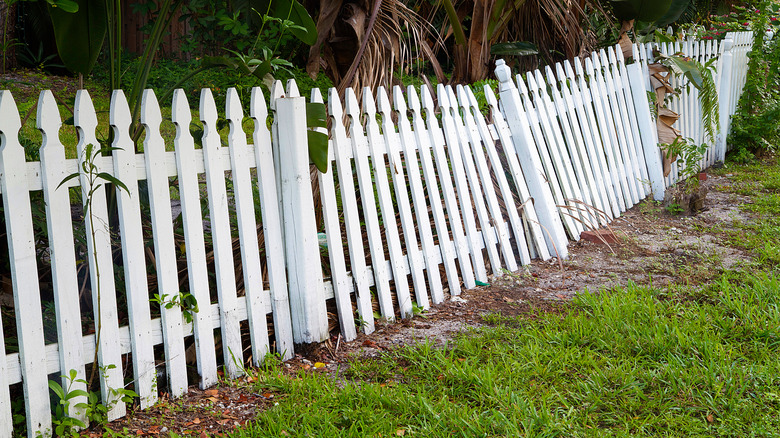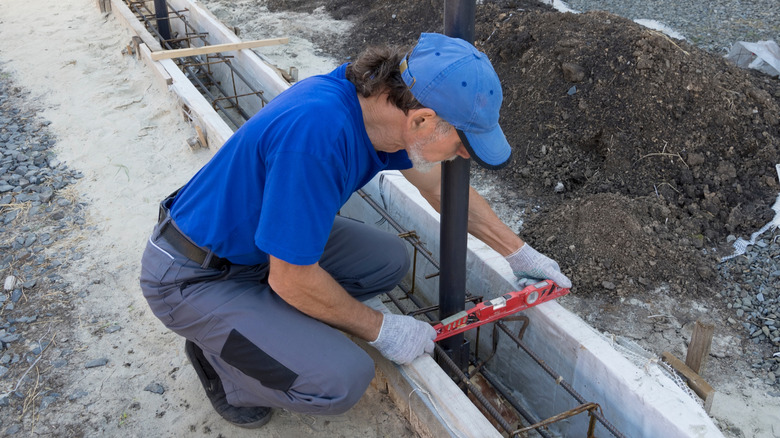Ditch Wood Fence Posts For A Sturdier Alternative
Wood fencing, while visually pleasing, relatively cheap in comparison to other fence materials, and good for the environment, also requires a lot of maintenance. If you don't do that maintenance, you may not have much of a fence to look at sooner than you planned for. There are reasons why paying for more expensive fence materials can be worth it, and one of the most practical reasons is their ability to better withstand the elements. Instead of having to choose between longevity and aesthetics, consider mixing and matching materials. A wooden fence will enhance the look of your lot, but if it's anchored by a sturdier material like metal, it will face significantly less damage from water rot and warping due to climate.
When people envision the typical version of the American dream — the dog and two smiling kids standing in front of the big house with the white picket fence — that picket fence is obviously made of wood. The visual of the white picket fence as a symbol of the good life goes back to 1950s Cold War era programming, where once past the gates, suburbanites could feel a sense of safety. In 2025, however, looking at the cost to build a fence, it makes sense to think as much about longevity as nostalgia and aesthetics. Steel fence posts can last 50 to 70 years with minimal maintenance, while wood fence posts are likely to decay faster than that, with specific times depending on region, weather, wood quality, insect activity, and so on.
Here's how to secure your metal posts in the ground
While wood is a classic, nowadays, you can find fence post materials that both are durable and stylish, even if they're made of an industrial material like metal. Once you have your metal posts, it's time to set them in the ground. There are various ways to install a fence post without cement, but where metal posts are concerned, concrete offers a more secure, longer lasting install than just digging a hole in the ground and sticking them in. You'll also need to employ a proper level and a line of string to ensure the straight alignment of your fence posts — nobody likes a crooked fence.
Dig the appropriate number of holes for your metal fence posts, ensuring the width of each hole is a little bigger than the post. For depth, you want your holes to be ⅓ to ½ the height of your metal posts above ground. For example, a 9 foot tall fence should sit between 3 and 4 ½ feet in the ground. Once your hole is dug, mix and pour in your cement — you can also use gravel, sand, crushed rock, or dirt — and insert your level metal posts into the hole. Once the cement has set, it's time to move on to assembling your fence.
Connect wooden cross beams to your metal posts and finish the job
This is when you need to attach wooden cross beams to your metal posts using fence brackets. Line up three wooden cross beams across your metal posts, ensuring your top, mid, and bottom tiers are spread apart about two feet from each other. Install your mount bracket to the post, pre-drill holes in your cross beams sized for 1 ½ inch exterior grade screws, and then screw your wooden cross beams to your metal posts.
Now that you have a foundation for your fence, place your fence post caps on your metal fence posts to keep water and the elements out of your newly installed pole. While metal posts last longer than wooden posts and are immune to pests like termites, ants, and other wood-destroying insects, they are particularly susceptible to rust. Aside from capping your fence posts, you can maintain the life of your metal posts by applying a protective layer like powder coating, zinc plating, or rust resistant paint. Now that your new fence post is up, here are 20 creative ways to repurpose old fence posts around your home and yard so nothing goes to waste.


